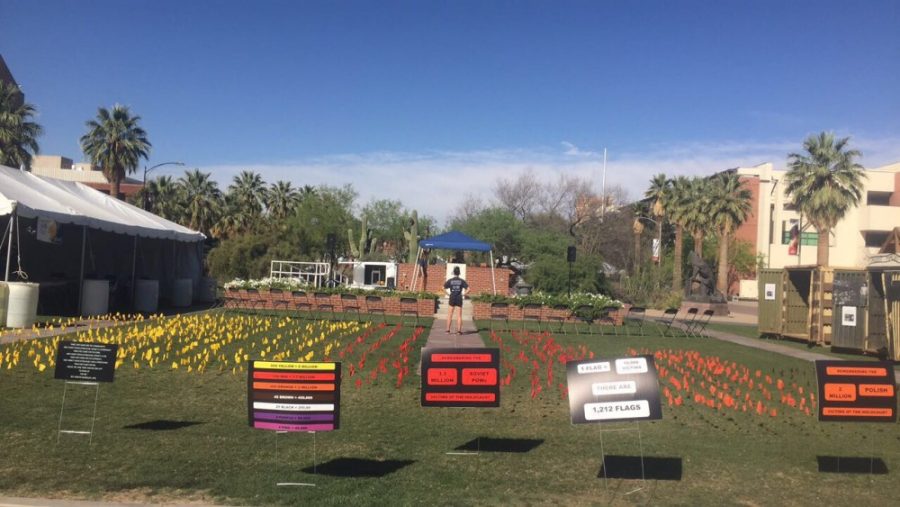The University of Arizona campus came together to honor and commemorate the 13 million lives lost during the Holocaust for the 27th Annual Holocaust Vigil on March 21.
“I knew about the Holocaust, but I’ve never seen it like this,” said Abhinav Nishant, an optical sciences graduate student. “It’s really hard, but I think it’s important for us to know about it. It’s important for us to do things like this and remember [the Holocaust] this way.”
More than 1,200 flags were placed on the UA Mall to physically symbolize the 13 million lives lost. Each flag represented 10,000 lives that perished during the Holocaust.
RELATED: UA’s The Merchant of Venice brings audiences serious issues within a Shakespearean dramedy
“Someone pointed out to me that just four of these flags symbolizes the entire population at [the University of Arizona],” said Calli Bagshaw, one of the event’s co-chairs. “I thought that was really powerful.”
Bagshaw has been working for over a year to help organize the vigil. She was involved with coordinating 96 volunteers that read the names of the 13 million departed lives continuously for 24 hours.
As many names as possible were read, but 24 hours was not adequate time for all 13 million names to be read.
“It was definitely stressful getting people to sign up, but they were very nice and very willing,” Bagshaw said. “The ZBT Fraternity is doing almost the whole night. They have 23 guys doing the 2 a.m. to 8 a.m. shift. Greek Life has helped out almost every year with the reading during the middle of the night shifts.”
Local Holocaust survivors Sidney Finkel, Pawel Lichter and Yulia Gemina spoke about their experiences during the Holocaust to middle school students from Tucson Hebrew Academy.
“It’s important that we talk about these things so that we don’t forget them,” said an attending student.
“It is our responsibility,” replied one of the speakers.
The vigil also included four immersive museum pods that allowed observers to physically step inside of life during the Holocaust and understand the massive suffering endured by the victims of the Holocaust.
Each pod was set around a different theme, from life pre-WWII to life inside of the Auschwitz concentration camp.
“We can’t bring Auschwitz to you, but we can show you the power of the space,” said Michelle Blumenburg, executive director of the University of Arizona’s Hillel Foundation. “We want to show you.”
The newest pod, Hidden Spaces, depicted life for those that went into hiding to survive during the Holocaust. On the right side of the pod, students were able to see a living space. On the left side of the pod was the hiding space used by those who hid to escape death.
Peering through the openings of the wood allows observers to truly digest the limitation and suffocation of a life in hiding.
“We decided to choose two poems from different children who perished in the Holocaust,” Stein said.
Attendees were able to glue glass and clay creations beside these significant poems from the Holocaust era, including Pavel Friedman’s poem “The Butterfly”.
RELATED: Holocaust Vigil returns to campus for 27th year
Friendman’s poem is monumental in meaning as it has become the basis for the Butterfly Project – a project of worldwide recognition and remembrance of the 1.5 million children lost throughout the Holocaust.
The Hillel Foundation has participated in the Butterfly Project for nearly five years, with eight different art installations throughout Tucson.
The decorated poems will now be donated to the Jewish History Museum in downtown Tucson, where they will be given out to local schools when they visit the museum.
Follow the Daily Wildcat on Twitter









